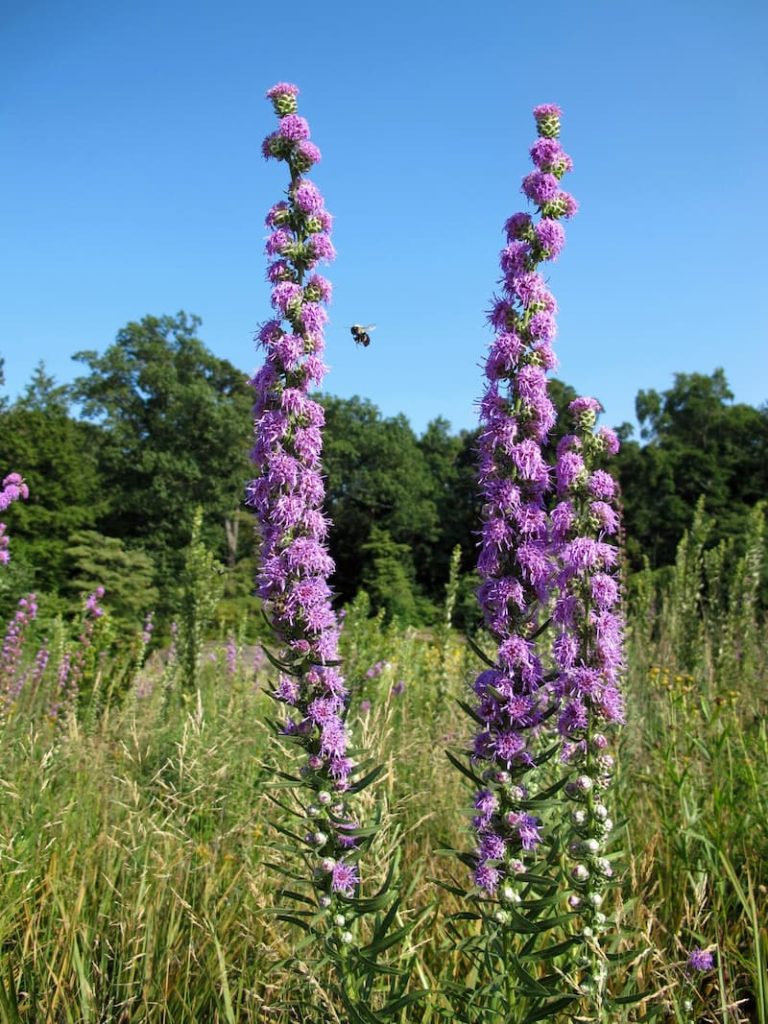Rough Blazing Star Attracts Pollinators
Photo:
Joshua Mayer from Madison, WI, USA, via Wikimedia Commons
Rough Blazing Star features fluffy, deep rose-purple flowers arranged in 1″ button-like heads. Blooming begins, as one would assume, at the top of the flower stalk and steadily progresses downward. The flower display continues from late summer until autumn for 3–4 weeks.
Discover more about its sister plants, the slender blazing star and the dense blazing star.
Quick Growing Guide
Botanical Name: Liatris aspera
Also Called: Button Blazing Star; Tall Blazing Star
En français: Liatris rugueux
See More Plants in this Botanical Family:
Colour:
Sun / Shade:
Water: Drought resistant, but watering helps develop flowers
Height:
Pollinators:
Care:
Pollinators and Fauna
Butterflies, skippers, and bees are greatly attracted to the flowers of the Rough Blazing Star. Butterfly visitors include Monarchs, Painted Ladies, Black Swallowtails, Sulfurs, and others. This is not unlike the Dense Blazing Star.
Many other insects also visit the flowers, including bumblebees, little carpenter bees, miner bees, Leaf-Cutting bees, Green Metallic bees, and other sweat bees. Herbivores, large and small, readily eat the foliage and stems, including rabbits, deer, and groundhogs.

Credit: Kristine Paulus, via Wikimedia Commons
Where do Rough Blazing Stars Grow?
The rough blazing star, Liatris aspera, is an upright, clump-forming perennial growing from 2-4′ tall (less frequently to 5′) in dry soils, especially in glades, meadows, prairies, open woods, roadsides, and along railroad tracks. Typically reaching four feet in height, it can reach five to six feet in ideal conditions.
Liatris’ drought-tolerant nature makes it ideal for well-drained dry to medium soils, sandy soils, or rocky terrain. Plant it away from humid areas or locations with consistently wet soil in the winter. Despite the fact that this species of Liatris has a root system that can spread and self-sow, it is not considered an invasive species.
Should I Deadhead the Blazing Star?
It is not necessary to deadhead blazing star plants because they bloom for weeks at a time. Pruning, however, the plants can encourage a second flowering after seasonal flowering has faded.
Is rough blazing star found in prairies?
They grow in upland and loess hill prairies, glades, upland forest openings, exposed ledges and tops of bluffs, savannas, and seldom along streams; they can also grow along railroads, pastures, and roadsides.
What eats a rough blazing star?
Among the mammals that consume blazing star foliage is woodchucks, rabbits, and deer. Also, birds consume the fruits of blazing stars, such as tiny sunflower seeds. Blazing star rootstocks with sweet, thickened textures are preferred by voles and other herbivorous mammals.
Medicinal Uses
Native Americans used the blazing star for a number of medicinal purposes. In addition to treating headaches, arthritis, and earaches with the roots, their roots were also used to reduce fevers, while the leaves were used for treating upset stomachs and antiseptics.
Are Rough Blazing Star perennials?
An Asteraceae (daisy) perennial, Rough Blazing Star grows from a corm. It is found in nature in hardiness zones 3 to 9, where it is a perennial. This species is commonly found in prairie glades and barren regions throughout the eastern and central US and parts of Canada. The flower spikes are showy purple and attract butterflies in late summer and fall.







Leave a Reply
You must be logged in to post a comment.